Saint Paul Union Depot
Saint Paul's Union Depot is a historic railroad station and intermodal transit hub in the Lowertown neighborhood of the city of Saint Paul, Minnesota, United States. It serves light rail, intercity rail, intercity bus, and local bus services.
Union Depot | ||||||||||||||||||||||||||||||||||||||||||||||||||||||||||||||||||||||||||||||||||||||||||||||||||||||||||||
|---|---|---|---|---|---|---|---|---|---|---|---|---|---|---|---|---|---|---|---|---|---|---|---|---|---|---|---|---|---|---|---|---|---|---|---|---|---|---|---|---|---|---|---|---|---|---|---|---|---|---|---|---|---|---|---|---|---|---|---|---|---|---|---|---|---|---|---|---|---|---|---|---|---|---|---|---|---|---|---|---|---|---|---|---|---|---|---|---|---|---|---|---|---|---|---|---|---|---|---|---|---|---|---|---|---|---|---|---|
     Left to right from top:facade of the head house, waiting room, concourse, inside of the headhouse, Entrance from lower parking ramp with ticket stations for Jefferson Lines and Amtrak | ||||||||||||||||||||||||||||||||||||||||||||||||||||||||||||||||||||||||||||||||||||||||||||||||||||||||||||
| Location | 214 Fourth Street East Saint Paul, Minnesota 55101 United States | |||||||||||||||||||||||||||||||||||||||||||||||||||||||||||||||||||||||||||||||||||||||||||||||||||||||||||
| Coordinates | 44°56′52″N 93°5′10″W | |||||||||||||||||||||||||||||||||||||||||||||||||||||||||||||||||||||||||||||||||||||||||||||||||||||||||||
| Owned by | Ramsey County Regional Railroad Authority | |||||||||||||||||||||||||||||||||||||||||||||||||||||||||||||||||||||||||||||||||||||||||||||||||||||||||||
| Operated by | Jones Lang LaSalle[1] | |||||||||||||||||||||||||||||||||||||||||||||||||||||||||||||||||||||||||||||||||||||||||||||||||||||||||||
| Line(s) | Canadian Pacific Railway Merriam Park Subdivision | |||||||||||||||||||||||||||||||||||||||||||||||||||||||||||||||||||||||||||||||||||||||||||||||||||||||||||
| Platforms | 9 historically 3 currently | |||||||||||||||||||||||||||||||||||||||||||||||||||||||||||||||||||||||||||||||||||||||||||||||||||||||||||
| Tracks | 18 historically 2 currently | |||||||||||||||||||||||||||||||||||||||||||||||||||||||||||||||||||||||||||||||||||||||||||||||||||||||||||
| Bus routes | ||||||||||||||||||||||||||||||||||||||||||||||||||||||||||||||||||||||||||||||||||||||||||||||||||||||||||||
| Bus stands | 6 | |||||||||||||||||||||||||||||||||||||||||||||||||||||||||||||||||||||||||||||||||||||||||||||||||||||||||||
| Bus operators | ||||||||||||||||||||||||||||||||||||||||||||||||||||||||||||||||||||||||||||||||||||||||||||||||||||||||||||
| Construction | ||||||||||||||||||||||||||||||||||||||||||||||||||||||||||||||||||||||||||||||||||||||||||||||||||||||||||||
| Parking | 12 short-term and 1000 long-term parking spaces | |||||||||||||||||||||||||||||||||||||||||||||||||||||||||||||||||||||||||||||||||||||||||||||||||||||||||||
| Bicycle facilities | Yes | |||||||||||||||||||||||||||||||||||||||||||||||||||||||||||||||||||||||||||||||||||||||||||||||||||||||||||
| Disabled access | Yes | |||||||||||||||||||||||||||||||||||||||||||||||||||||||||||||||||||||||||||||||||||||||||||||||||||||||||||
| Other information | ||||||||||||||||||||||||||||||||||||||||||||||||||||||||||||||||||||||||||||||||||||||||||||||||||||||||||||
| Station code | MSP | |||||||||||||||||||||||||||||||||||||||||||||||||||||||||||||||||||||||||||||||||||||||||||||||||||||||||||
| Website | http://www.uniondepot.org/ | |||||||||||||||||||||||||||||||||||||||||||||||||||||||||||||||||||||||||||||||||||||||||||||||||||||||||||
| History | ||||||||||||||||||||||||||||||||||||||||||||||||||||||||||||||||||||||||||||||||||||||||||||||||||||||||||||
| Opened | Original depot: 1881 Current structure built 1917–1923 | |||||||||||||||||||||||||||||||||||||||||||||||||||||||||||||||||||||||||||||||||||||||||||||||||||||||||||
| Rebuilt | 2011 | |||||||||||||||||||||||||||||||||||||||||||||||||||||||||||||||||||||||||||||||||||||||||||||||||||||||||||
| Traffic | ||||||||||||||||||||||||||||||||||||||||||||||||||||||||||||||||||||||||||||||||||||||||||||||||||||||||||||
| Passengers (2016) | 96,539[2] | |||||||||||||||||||||||||||||||||||||||||||||||||||||||||||||||||||||||||||||||||||||||||||||||||||||||||||
| Services | ||||||||||||||||||||||||||||||||||||||||||||||||||||||||||||||||||||||||||||||||||||||||||||||||||||||||||||
| ||||||||||||||||||||||||||||||||||||||||||||||||||||||||||||||||||||||||||||||||||||||||||||||||||||||||||||
| ||||||||||||||||||||||||||||||||||||||||||||||||||||||||||||||||||||||||||||||||||||||||||||||||||||||||||||
Union Depot | ||||||||||||||||||||||||||||||||||||||||||||||||||||||||||||||||||||||||||||||||||||||||||||||||||||||||||||
| Location | 214 Fourth Street East Saint Paul, Minnesota | |||||||||||||||||||||||||||||||||||||||||||||||||||||||||||||||||||||||||||||||||||||||||||||||||||||||||||
| Coordinates | 44°56′52″N 93°5′10″W | |||||||||||||||||||||||||||||||||||||||||||||||||||||||||||||||||||||||||||||||||||||||||||||||||||||||||||
| Built | 1917 | |||||||||||||||||||||||||||||||||||||||||||||||||||||||||||||||||||||||||||||||||||||||||||||||||||||||||||
| Architect | Charles S. Frost | |||||||||||||||||||||||||||||||||||||||||||||||||||||||||||||||||||||||||||||||||||||||||||||||||||||||||||
| Architectural style | Classical Revival | |||||||||||||||||||||||||||||||||||||||||||||||||||||||||||||||||||||||||||||||||||||||||||||||||||||||||||
| Part of | Lowertown Historic District (ID83000935) | |||||||||||||||||||||||||||||||||||||||||||||||||||||||||||||||||||||||||||||||||||||||||||||||||||||||||||
| NRHP reference No. | 74001040[3] | |||||||||||||||||||||||||||||||||||||||||||||||||||||||||||||||||||||||||||||||||||||||||||||||||||||||||||
| Significant dates | ||||||||||||||||||||||||||||||||||||||||||||||||||||||||||||||||||||||||||||||||||||||||||||||||||||||||||||
| Added to NRHP | December 18, 1974 | |||||||||||||||||||||||||||||||||||||||||||||||||||||||||||||||||||||||||||||||||||||||||||||||||||||||||||
| Designated CP | February 21, 1983 | |||||||||||||||||||||||||||||||||||||||||||||||||||||||||||||||||||||||||||||||||||||||||||||||||||||||||||
| Location | ||||||||||||||||||||||||||||||||||||||||||||||||||||||||||||||||||||||||||||||||||||||||||||||||||||||||||||
 Union Depot Location in Minnesota  Union Depot Location in United States | ||||||||||||||||||||||||||||||||||||||||||||||||||||||||||||||||||||||||||||||||||||||||||||||||||||||||||||
It is the eastern terminus for the METRO Green Line light rail line, with the stop located outside the station's headhouse. It is also the Twin Cities' stop for Amtrak, the national intercity railroad service. In addition to rail, Union Depot also serves Metro Transit, MVTA, Jefferson Lines, Greyhound, and MegaBus.
The headhouse, located at the 4th Street entrance, was designed by architect Charles Sumner Frost and is neoclassical in style. The concourse and the waiting room that extend over the tracks are viewed as a great architectural achievements. The building was added to the National Register of Historic Places in 1974. It is also a contributing property to the Lowertown Historic District.[4]
In addition to its transit uses, Union Depot also contains a Hertz rental car location, coffee shop, restaurant, a bike shop, offices, a museum, and loft condominiums.[5]
History
Original Union Depot
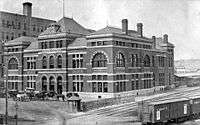
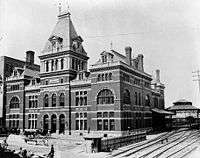
There have been two Union Depots in Saint Paul. The first was completed in 1881, and combined the services of several different railroads into one building (hence the "union"; see Union station). In 1888 the old station had its peak year, handling eight million passengers. That year, about 150 trains departed daily. Around this time, the building was remodeled with a taller central tower and other alterations to the roofline. This station burned in 1915.
Current building
The current structure was started in 1917 but was not completed until 1923 because World War I caused construction to halt for several years.
During its heyday, the depot hosted the passenger trains of nine railroads, and more than 20 million pieces of mail passed through the station to the neighboring St. Paul Central Downtown Post Office annually. At its peak in the 1920s, there were 282 train movements daily. The waiting room stood atop nine platforms serving 18 tracks; the eight northern ones closest to the headhouse were stub-end tracks, while the other ten ran through. However, track ownership and trackage rights west of the station meant that most trains operated as though the station was a stub terminal. These trains, when they were intended to continue beyond the station, instead backed up to a wye just to the east to get to other main lines.[6]
The Saint Paul Union Depot Company controlled 9.24 miles (14.87 km) of St. Paul trackage and terminal facilities, including the depot building. The company was operated in tandem with the Minnesota Transfer Railway Company, with effective control of both properties exercised by the same board, composed of representatives of the nine tenants.[7]
Train ridership began to erode in the 1920s as the automobile took hold and airlines began to operate. The railroads sought ways stem the flow of passengers and compete with these new forms of transportation. As the Great Depression unfolded, more aggressive moves were required. The streamliner era in the United States began in 1934 with the introduction of the Chicago, Burlington and Quincy's Zephyr. After making a "Dawn-to-Dusk Dash" from Chicago to Denver, Colorado, the CB&Q's interest soon turned to the Twin Cities run. A demonstration run was completed in 6 hours and 4 minutes, including six one-minute stops.[8] Other railroads were soon busy investigating how to run faster trains to Saint Paul and Minneapolis.
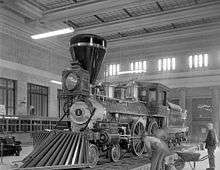
The first locomotive to run in Minnesota, the William Crooks, was displayed at the depot from 1955 until the station's 1971 closure, after which it was moved to the Lake Superior Railroad Museum in Duluth.
Early high-speed trains
On January 2, 1935, high-speed express service to Chicago was introduced on the Chicago and North Western Railway's 400, cutting the scheduled time between the two cities from about 10 hours down to 7. Time dubbed the 400, "the fastest train scheduled on the American Continent, fastest in all the world on a stretch over 200 mi."[9] The C&NW beat two other railroads which had been planning 6½ hour service to begin in the spring. The Milwaukee Road's Hiawatha and the Burlington Route's Twin Cities Zephyr were introduced with 6½ hour service a few months later at the same time, and C&NW matched their schedules.[8][10]
The Burlington Zephyrs were the first streamlined diesel-electric trains to serve the Twin Cities, and originally ran in an articulated configuration. The 400 (now renamed the Twin Cities 400) followed in 1939, but using more conventional trucks and couplers to link passenger cars together. The Hiawatha had always been powered by a streamlined (or, in the terminology of the Milwaukee Road, "speedlined") steam locomotive. The Twin Cities Zephyrs added a second set of trains daily in 1936, running the Morning Zephyr and Afternoon Zephyr from each terminal. The Hiawatha added a second set of trains in 1939, and the Morning Hiawatha and Afternoon Hiawatha each provided daily service from Minneapolis-St. Paul and Chicago.
The Morning Hiawatha may have held the record as the world's fastest steam train on two or more measures: The 78.3 miles (126.0 km) run from Sparta to Portage, Wisconsin was scheduled for 58 minutes—an average of 81 miles per hour (130 km/h). Speeds up to and above 100 miles per hour (160 km/h) were achieved on a daily basis, and the powerful Milwaukee Road class F7 engines (designed for a "reserve speed" of 125 miles per hour (201 km/h)) likely ran more miles at or above 100 miles per hour (160 km/h) than any other steam locomotives in history.[11]
Burlington's diesel Zephyrs were also very fast, and they had to be—the Zephyr route was about 20 miles (32 km) longer than the competition. In southwestern Wisconsin, a stretch of track between stations required an average speed of 84.4 miles per hour (135.8 km/h).
Eventually, the Hiawathas, Zephyrs, and the 400 ran 6¼-hour service between St. Paul and Chicago, and for a time the Morning Zephyr from Chicago reached St. Paul in six hours flat.[12] In the 1950s, the federal government began imposing stricter rules for high-speed operation, and expensive advanced signaling was installed along the routes to the Twin Cities, though trains generally traveled a maximum of 90 to 100 mph (140 to 160 km/h). Unable to keep up with an increasing automobile speeds on an improving road network and other factors that kept passengers away from trains, train ridership declined and the five daily fast trains became unprofitable.
End of service
The Twin Cities 400 was the first victim, ending service on July 23, 1963.
It was announced that when Amtrak formally took over most passenger service on May 1, 1971, it would consolidate its Twin Cities service in Minneapolis at the Minneapolis Great Northern Depot. Accordingly, the Burlington (later Burlington Northern) Zephyrs ended service on April 30, 1971, the same day the depot closed. The Afternoon Zephyr was the last train to serve the depot when it departed that evening bound for Minneapolis. At this time, this train was normally combined with the Empire Builder and North Coast Limited from Chicago to St. Paul, except on Fridays when it ran as a separate train. Since April 30 was a Friday, the Zephyr had the "honor" of being the last train to depart the station.[13]
Restoration and return of passenger service
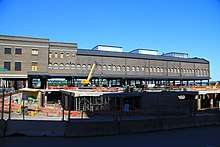
Area boosters had long hoped that trains would return to the Union Depot, and plans gathered steam as the Blue Line light rail project in Minneapolis drew toward completion. Planners envisioned the depot being used for a restored Amtrak service along with Metro and Jefferson Lines buses.
A few businesses had occupied the headhouse since the halt of train service in 1971, while the United States Postal Service (USPS) took over the rear of the building. The concourse and waiting room were used for some postal service activities and storage. After lying dormant for several years in the 1970s, the train tracks were removed from the train deck and it was paved with a flat surface. It began to be used for staging semi-trailer trucks carrying mail to and from the neighboring Downtown St. Paul Central Post Office as well as USPS employee parking. A driveway ramp was sliced into the train deck at the intersection of Kellogg Boulevard and Broadway Street for USPS vehicles. In the early 2000s, the upper levels of the headhouse were converted into 33 2-story loft condominiums.[14]
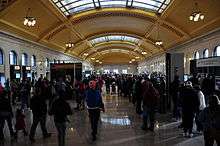
In 2005, the Ramsey County Regional Railroad Authority secured funding to renovate the station as an intermodal transit hub served by Amtrak trains, Metro Transit light rail, and intercity bus lines.[15][16][17]
In June 2009, the Ramsey County Board approved purchasing the depot headhouse for $8.2 million, to serve as a METRO Green Line light rail station and for future passenger rail use.[18] In 2010, USPS moved most of the truck operations to a bulk mail processing center in Eagan, Minnesota, making way for rehabilitation of the depot as a rail hub. Demolition of the Postal Service building that blocked track access to the station began in mid-March 2011. The USPS ramp cut all the way across the train deck and blocked the ability for tracks to be installed, so the ramp was modified during restoration to make a roughly right-angle turn to access new bus platforms on the north end of the train deck while freeing up room for a few tracks to be restored on the south end.
The renovation was completed in late November 2012 at a cost of $243 million, of which $35 million was provided by the US government through the TIGER program.[19] The renovated station re-opened to the public on December 8, 2012.[15][16][17]
The first Amtrak train to service Saint Paul Union Depot was the westbound Empire Builder which stopped at the station at 11:30pm on May 7, 2014, 70 minutes late heading en route to Seattle and Portland. Officials welcomed the first passengers to depart the train at the depot.[20]
Special Events
Since opening in late 2012,[15] the Depot has hosted a number of events. On May 10, 2014 (National Train Day), the depot hosted Great Northern Railway Historical Society's SD45 #400 (Hustle Muscle) from the Jackson Street Roundhouse, as well as some historical equipment. Amtrak displayed three Superliner cars. There were several other displays around the Depot grounds.
In December 2014, for the first time in nearly 50 years, an active steam locomotive returned to St. Paul Union Depot. Milwaukee Road 261 and some historic passenger cars, decorated as the "North Pole Express" ran short excursions to and from the depot. It was determined to be an overwhelming success, with intentions to operate the train again in 2015. While Milwaukee Road 261 was present, the Depot also got a visit from Canadian Pacific's traveling Holiday Train.
On May 9, 2015, the depot hosted National Train Day events once more, with GN SD45 #400 from the Great Northern Railway Historical Society and Jackson Street Roundhouse, BNSF Railway sent a GE ES44C4 to the event and pulled some of the Milwaukee Road 261 excursion cars that were also displayed there. Amtrak displayed a new Viewliner II baggage car that was about to begin service on the Empire Builder.
On December 9, 2017 Metro Transit and BNSF operated a Northstar Holiday Train between Big Lake and St. Paul Union Depot. Service was free of charge, and ridership was around 1,500. The event has become an annual tradition.
Union Depot Train Day
Every year in May, the depot hosts a weekend of events named "Train Day" which showcases the history and future of railroad travel. Those in attendance are treated to model train layouts, exhibitors, tours and railroad equipment displays. This event replaced "National Train Day" after Amtrak disbanded the program after 2015.[21]
On April 30 and May 1, 2016, the depot hosted a two-day event titled "Union Depot Train Days" to celebrate the building's 90th Anniversary. Various displays, vendors, and photographers were featured inside the depot. Outside featured numerous rail equipment, including Milwaukee Road 261 under steam with 4 passenger cars, Amtrak's Exhibit Train, Twin Cities and Western Railroad locomotive, Great Northern 325, a rare EMD SDP40 and Northern Pacific RPO #1102 from the Minnesota Transportation Museum, and Soo Line FP7a #2500.[22]
On May 6, 2017, featured railroad equipment included Amtrak 42, the Veteran's locomotive, two Union Pacific locomotives, a TC&W locomotive and GN 325 and NP 1102. NP RPO #1102 had the distinction of being the "Last Mail Train" as Train Day attendees had mail transported inside the car from Union Depot to Osceola, Wisconsin.[23]
On May 5, 2018, Burlington Northern 6234 and Soo Line 559 were displayed along with Great Northern business car A-11, once an executive car for James J. Hill's family, along with Union Pacific's Chicago & Northwestern 'heritage' locomotive.[24] 2019 Train Days was held May 31-June 2 and featured Soo Line 700 from Duluth and other unannounced equipment.[25]
Services
Amtrak
.jpg)
Serving this station is the Empire Builder, named to honor Saint Paul-based mogul James J. Hill who constructed the Great Northern Railroad, and whose nickname was "The Empire Builder". Westbound trains head for Spokane, Washington and split there to serve both Seattle, Washington and Portland, Oregon; eastbound trains head for Chicago.
The Empire Builder originally stopped at the station from 1929 until 1971. In 1971, Amtrak consolidated all passenger rail service for the Twin Cities at the Great Northern Station in Minneapolis, and in 1978 moved to the Midway Station in Saint Paul, about halfway between the downtowns of the two cities.[26] Service returned to the Union Depot from Midway in 2014 after it was delayed for almost two years from the depot's initial grand re-opening in 2012 due to negotiations with the owners of the railroads (Canadian Pacific Railway, BNSF Railway, and Union Pacific Railroad) in the area[27] and the construction of new complex signals on the Merriam Park Subdivision.[28]
Westbound trains arrive from Chicago in the middle of the night, usually around 10:30 p.m. Eastbound trains arrive from Seattle or Portland around breakfast time. Also included is an Amtrak Thruway Motorcoach to Duluth via Jefferson Lines. The station appears as St. Paul-Minneapolis in Amtrak timetables.
Light rail

The depot serves as the METRO Green Line light rail line's eastern terminus. The Green Line runs between St. Paul and Minneapolis with its western terminus at Target Field station in the North Loop area of Downtown Minneapolis. The stop is in front of the headhouse, rather than at a platform under the waiting room.
The line opened on June 14, 2014. Utility relocation work in preparation for the Green Line began in front of the depot on 4th Street in August 2009, well before the line received final funding or approval.[29] Track was laid from 2011–2012.[30] While the Union Depot is the eastern terminus of service, the tracks continue beyond the station to the line's maintenance facility.[31]
Intercity bus service
- Greyhound Lines arrived at Saint Paul Union Depot in March 2014 after initially pulling out of the project two years prior.[32] Greyhound offers at least six coach bus departures a day and additional weekend service.
- Jefferson Lines relocated from Midway Station to Saint Paul Union Depot in 2013.[33]
- Megabus[34]
Local and regional bus service
- Metro Transit: 3, 16, 21, 54, 63, 70, 94, 262, 350, 351, 361, 364 and 417.
- Minnesota Valley Transit Authority: 480, 484, 489.[35]
Planned services
The current vision for the depot is to create a hub for intercity connections for local & regional bus service, light rail, and commuter rail.
Light rail and bus rapid transit
Bus rapid transit (BRT) has been selected for the Rush Line Corridor between St. Paul and White Bear Lake. The southern terminus of this route is planned to be at St. Paul Union Depot. The Gateway Corridor (now called the Gold Line) is also planned to be bus rapid transit and will operate between St. Paul and Woodbury. The Red Rock Corridor has also been proposed as a BRT service and eventually being upgraded to commuter rail, however plans are on hold as ridership on the current bus routes in this corridor are low.
The Riverview Corridor is planned to be a LRT/modern streetcar hybrid operating between St. Paul Union Depot and Mall of America. Riverview Corridor trains would share tracks and stations with the Metro Green Line between Central Station and Union Depot Station.
Regional rail
Numerous existing freight rail lines branch out from St. Paul Union Depot and could be upgraded and utilized by regional passenger trains. Currently MnDOT has studied regional rail from St. Paul Union Depot to Mankato, Northfield, and Minneapolis (continuing further west as a through-service). In 2010, the Minnesota Department of Transportation also released a plan for regional rail stretching out from the Twin Cities to rural Minnesota and neighboring states, and at least some of the lines would run to Saint Paul.[36]
High-speed rail
New trains running at speeds above 100 miles per hour (160 km/h) to Chicago have also been discussed since at least 1991. The Midwest Regional Rail Initiative (MWRRI), led by the Wisconsin Department of Transportation, has proposed a link to the Twin Cities running at up to 110 mph (180 km/h). The planned schedule time to Saint Paul would be just 5½ hours. Others including the French national railway SNCF, which operates the TGV network, have proposed trains running at up to 220 miles per hour (350 km/h).[37][38]
Local significance


Prior to the station's reopening in December 2012, Josh Collins, a spokesperson for Ramsey County Regional Rail Authority, referred to the potential of the station to be "the living room of Saint Paul."[39]
Architecture
The entrance to Union Depot, the headhouse, is considered a somewhat severe example of neoclassical architecture, with a robust aesthetic. A series of tall Doric columns line the front façade. The concourse and the waiting room that extends out to the platforms, where trains once rolled in, is considered to be one of the great architectural achievements in the city. The building was designed by Charles Frost.[39]
The waiting room is flooded with natural light from skylights. These skylights were blackened during the Second World War, but restored for the 2012 re-opening.[39]
The building was added to the National Register of Historic Places[39] in 1974.
The restoration and new addition were designed by Hammel, Green and Abrahamson Architects & Engineers (HGA).
Railway mapping
Milepost for rail lines that originated in Saint Paul, such as the Great Northern and Northern Pacific, had used the depot as milepost 0. This is still evident in timetables and mileposts used by the BNSF Railway[40]
See also
Other notable trains to serve the depot
- Twin Star Rocket
- Gopher and Badger
- North Coast Limited
- Western Star
Other rail stations in the Twin Cities
- Chicago, Milwaukee, St. Paul and Pacific Depot Freight House and Train Shed - Minneapolis destination for Milwaukee Road, Soo Line, and Rock Island Railroad passenger trains; now converted to other uses
- The Minneapolis Great Northern Depot in Minneapolis was used by trains of the Chicago and North Western Railway, Great Northern Railway, and Northern Pacific railroads
- The Chicago Great Western Railway had a station on south Washington Avenue in Minneapolis
- The Minneapolis and St. Louis Railway had a station on north 5th Street in Minneapolis
- Midway Station - former Amtrak station
- Target Field Station - terminus for the Northstar Line commuter trains
Regional and enhanced-speed train proposals
Other initially abandoned stations
- Kansas City Union Station - An Amtrak station that was abandoned in 1985, but restored in 2002
- Cincinnati Union Terminal - An Amtrak station that was abandoned in 1972, but restored in 1991
References
- "Contract with Jones Lang LaSalle for services at Union Depot approved". Ramsey County Regional Rail News. Ramsey County Regional Rail Authority. July 25, 2012. Archived from the original on March 30, 2013. Retrieved December 6, 2012.
- "Amtrak Fact Sheet, FY2016, State of Minnesota" (PDF). Amtrak. November 2016. Retrieved February 20, 2017.
- "National Register Information System". National Register of Historic Places. National Park Service. March 15, 2006.
- "Lowertown Historic District". Minnesota National Register Properties Database. Minnesota Historical Society. 2009. Retrieved January 9, 2013.
- Browender, Wolfie (March 14, 2018). "Living in Union Depot". streets.mn. Retrieved March 16, 2020.
- "Saint Paul Union Depot Analysis Final Report" (PDF). Retrieved February 4, 2010.
- "Saint Paul Union Depot Company". Retrieved May 10, 2014.
- Scribbins, Jim (2007) [1970]. The Hiawatha Story. Minneapolis, MN: University of Minnesota Press. ISBN 0-8166-5003-9. OCLC 191732983.
- "400". Time Magazine Archive. January 14, 1935. Retrieved March 8, 2007.
- Scribbins, Jim (2008) [1982]. The 400 Story. Minneapolis, Minnesota: University of Minnesota Press. ISBN 978-0-8166-5449-9.
- Benn, Bryan. "Fastest Steam Locomotive?". Archived from the original on April 20, 2006. Retrieved February 8, 2010.
- "Heritage from the Gods: Burlington's new 8 car Twin Zephyrs" (PDF). Burlington Route. 1937. Retrieved May 10, 2014.
- Steve Glischinski, eyewitness account at depot on April 30, 1971.
- "Union Depot Lofts". StPaulCondos.com. Retrieved March 16, 2020.
- Shenoy, Rupa (December 8, 2012). "Party marks reopening of St. Paul's Union Depot". minnesota.cbslocal.com. MediaNews Group. Retrieved May 10, 2014.
- Melo, Frederick (December 8, 2012). "Thousands Visit St. Paul's Newly Renovated Union Depot". minnesota.cbslocal.com. MediaNews Group. Retrieved May 10, 2014.
- "Renovation". www.stpauluniondepot.com. Archived from the original on May 12, 2014. Retrieved May 10, 2014.
- "St. Paul Union Depot purchase approved". Railway Age. June 4, 2009. Retrieved June 9, 2009.
- "USDOT approves TIGER grant agreement for Minnesota's Union Depot". www.progressiverailroading.com. Progressive Railroading. November 18, 2010. Retrieved November 20, 2010.
- Melo, Fredrick (May 7, 2014). "After 43 years, St. Paul's Union Depot marks return of passenger trains". twincitiespress.com. MediaNews Group. Retrieved May 10, 2014.
- http://www.uniondepot.org/traindays/
- https://www.eventbrite.com/e/laker-rail-program-friday-night-photoshoot-tickets-20920727459#
- "Railroad Photo Sessions - Union Depot St. Paul / Osceola". Eventbrite. Retrieved April 17, 2019.
- "LakerRail 2018". Eventbrite. Retrieved April 17, 2019.
- "LakerRail 2019 Railroad Photography Show and Night Photo Session". Eventbrite. Retrieved April 17, 2019.
- Melo, Fredrick (May 7, 2014). "After 43 years, St. Paul's Union Depot marks return of passenger trains". twincitiespress.com. MediaNews Group. Retrieved May 10, 2014.
- Gilbert, Curtis (April 2, 2014). "Amtrak sets May 7 return to St. Paul's Union Depot". www.mprnews. Minnesota Public Radio. Retrieved May 2, 2014.
- "Amtrak's arrival delayed. Union Depot welcomes Jefferson Bus Lines, whose chair now runs MnDOT". twincites.com. MediaNews Group. January 14, 2013. Retrieved May 10, 2014.
- Yuen, Laura (August 10, 2010). "St. Paul's Lowertown dealing with light rail construction headaches". minnesota.publicradio.com. Minnesota Public Radio. Retrieved September 10, 2010.
- "Construction Update: Downtown St. Paul - Week of September 20, 2010". myemail.constantcontact.com. Central Corridor Light Rail Transit. September 2010. Retrieved September 18, 2010.
- "Central Corridor LRT construction schedule at a glance". Central Corridor. Metropolitan Council. July 20, 2010. Archived from the original on September 24, 2010. Retrieved September 18, 2010.
- Melo, Fredrick (March 10, 2014). "Greyhound coming to St. Paul's Union Depot". twincitiespress.com. MediaNews Group. Retrieved May 10, 2014.
- "Union Depot Welcomes Inner City Bus Service". minnesota.cbslocal.com. January 14, 2013. Retrieved May 10, 2014.
- Melo, Fredrick (January 23, 2014). "Megabus coming to St. Paul's Union Depot". twincitiespress.com. MediaNews Group. Retrieved May 10, 2014.
- "These routes will change on Dec. 8". Connect. Metro Transit. December 2012. Retrieved December 6, 2012.
- Cambridge Systematics, Inc., Kimley Horn and Associates, Inc., and TKDA, Inc. (December 2009). "Minnesota Comprehensive Statewide Freight and Passenger Rail Plan (Draft Final Report)" (PDF). Minnesota Department of Transportation. Retrieved February 8, 2010.CS1 maint: multiple names: authors list (link)
- "Midwest" (PDF). SNCF. September 14, 2009. Retrieved December 6, 2012.
- Freemark, Yonah (September 19, 2009). "SNCF Proposes Development of High-Speed Rail in Midwest, Texas, Florida, and California Corridors". The Transport Politic. Retrieved December 6, 2012.
- Duchschere, Kevin (December 5, 2012). "A new day is coming for St. Paul's Union Depot". Star Tribune. Retrieved December 5, 2012.
- BNSF Twin Cities Division Timetable No. 2. November 17, 2004. Note: The Midway Subdivision and St. Paul Subdivision both begin at Seventh Street junction. The Staples Subdivision (ex combined GN and NP) and Wayzata Subdivision (ex GN) continue the numbering.
Sources
- Black, Sam (December 10, 2009). "Mortenson team picked for $150M St. Paul Union Depot transit hub". Minneapolis / St. Paul Business Journal. Retrieved December 16, 2009.
- Diers, John (1913). St. Paul Union Depot. Minneapolis: University of Minnesota Press. ISBN 978 0 8166 5610 3
- Mack, Doug. (August 11, 2004). Goodbye Mail, Hello Rail. Professor Yeti. Retrieved June 12, 2005.
- Nelson, Tim (June 7, 2005). "Post office proposes Eagan move". Saint Paul Pioneer Press. Retrieved June 12, 2005.

